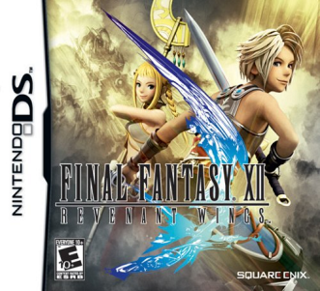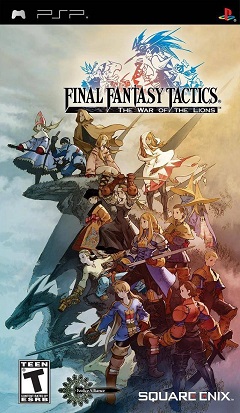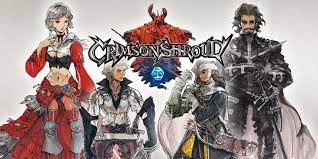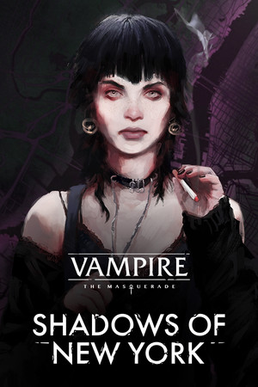Final Fantasy is a fantasy anthology media franchise created by Hironobu Sakaguchi which is owned, developed, and published by Square Enix. The franchise centers on a series of fantasy role-playing video games. The first game in the series was released in 1987, with 16 numbered main entries having been released to date.

Baldur's Gate is a series of role-playing video games set in the Forgotten Realms Dungeons & Dragons campaign setting. The series has been divided into two sub-series, known as the Bhaalspawn Saga and the Dark Alliance, both taking place mostly within the Western Heartlands, but the Bhaalspawn Saga extends to Amn and Tethyr. The Dark Alliance series was released for consoles and was critically and commercially successful. The Bhaalspawn Saga was critically acclaimed for using pausable realtime gameplay, which is credited with revitalizing the computer role-playing game (CRPG) genre.

Fallout is a media franchise of post-apocalyptic role-playing video games created by Tim Cain and Leonard Boyarsky, at Interplay Entertainment. The series is set during the first half of the 3rd millennium, and its atompunk retrofuturistic setting and artwork are influenced by the post-war culture of the 1950s United States, with its combination of hope for the promises of technology and the lurking fear of nuclear annihilation. Fallout is regarded as a spiritual successor to Wasteland, a 1988 game developed by Interplay Productions.

Final Fantasy Tactics Advance is a 2003 tactical role-playing game developed and published by Square for the Nintendo Game Boy Advance. A spin-off of the Final Fantasy series, the game shares several traits with 1997's Final Fantasy Tactics, although it is not a direct sequel. The player assembles a clan of characters, and controls their actions over grid-like battlefields. Players are mostly free to decide the classes, abilities, and statistics of their characters.

Pokémon Colosseum is a role-playing video game developed by Genius Sonority and published by The Pokémon Company and Nintendo for the GameCube. A spin-off of the Pokémon series, it was released on November 21, 2003 in Japan, March 22, 2004 in North America and May 14, 2004 in Europe. Unlike previous titles' random encounters with Pokémon, Colosseum allows the player to steal ("snag") the Pokémon of other Pokémon Trainers. The game also features single-player and multiplayer battle modes.

Terranigma is a 1995 action role-playing game developed by Quintet for the Super Nintendo Entertainment System (SNES), with manga artist Kamui Fujiwara acting as the character designer. The game tells the story of the Earth's resurrection by the hands of a boy named Ark, and its progress from the evolution of life to the present day. The game is the second entry in an unofficial trilogy of action role-playing games created by Quintet, also including Illusion of Gaia (1993) and The Granstream Saga (1997).

Illusion of Gaia, known in PAL territories as Illusion of Time, is an action role-playing video game developed by Quintet for the Super Nintendo Entertainment System. The game was released in Japan by Enix in 1993, and in North America and PAL territories by Nintendo in 1994 and 1995. Set in a fantasy reimagining of Earth, the game's plot centers on a boy named Will who is chosen to save the world from an impending disaster. Throughout the game, the player guides Will through levels inspired by the ancient ruins of real-world civilizations and Wonders of the World, including the Great Pyramid and the Great Wall of China.
Tactical role-playing games, also known as strategy role-playing games and in Japan as simulation RPGs, are a video game genre that combines core elements of role-playing video games with those of tactical strategy video games. The formats of tactical RPGs are much like traditional tabletop role-playing games and strategy games in appearance, pacing, and rule structure. Likewise, early tabletop role-playing games are descended from skirmish wargames such as Chainmail, which were primarily concerned with combat.

Shadow the Hedgehog is a 2005 platform game developed by Sega Studios USA and published by Sega. It is a spin-off from the Sonic the Hedgehog series starring the character Shadow. It follows the amnesiac Shadow's attempts to learn about his past during an alien invasion. Gameplay is similar to previous Sonic games, featuring fast-paced platforming and ring collecting, but introduces third-person shooter and nonlinear elements. Shadow uses a variety of weapons to defeat enemies and complete missions that determine the plot and playable levels.

Fire Emblem: Shadow Dragon and the Blade of Light is a tactical role-playing video game developed by Intelligent Systems and Nintendo and published by Nintendo for the Family Computer. It is the first installment in the Fire Emblem series and was originally released in Japan in 1990. Set on the fictional continent of Archanea, the story follows the tale of Marth, prince of the kingdom of Altea, who is sent on a quest to reclaim his throne after being forced into exile by the evil sorcerer Gharnef and his dark master Medeus, the titular Shadow Dragon. Forming new alliances with neighboring kingdoms, Marth must gather a new army to help him retrieve the sacred sword Falchion and the Fire Emblem shield in order to defeat Gharnef and Medeus and save his kingdom. The gameplay revolves around turn-based battles on grid-based maps, with defeated units being subject to permanent death.

Fantasy Flight Games (FFG) is a game developer based in Roseville, Minnesota, United States, that creates and publishes role-playing, board, card, and dice games. As of 2014, it is a division of Asmodee North America.

Final Fantasy XII: Revenant Wings is a real-time tactical role-playing game developed by Think & Feel and Square Enix and published by Square Enix for the Nintendo DS. It is a stand-alone sequel to the 2006 PlayStation 2 role-playing video game Final Fantasy XII.

Final Fantasy Tactics: The War of the Lions is a tactical role-playing game developed and published by Square Enix for the PlayStation Portable (PSP). The game is an updated version of Final Fantasy Tactics made for the PlayStation, which was released in 1997.

Tom Clancy's Ghost Recon: Shadow Wars is a turn-based tactics video game for the Nintendo 3DS developed and published by Ubisoft in 2011. The game is part of the Ghost Recon series of the Tom Clancy games. First images of the game were leaked by IGN in 2010. The game was released on March 25, 2011 in Europe, March 27 in North America, and March 31 in Australia as a launch title for Nintendo's new console. It was later released in Japan on May 19, 2011. The game released in North America five days before the Nintendo 3DS North American launch.

Final Fantasy is a 1987 role-playing video game developed and published by Square. It is the first game in Square's Final Fantasy series, created by Hironobu Sakaguchi. Originally released for the NES, Final Fantasy was remade for several video game consoles and is frequently packaged with Final Fantasy II in video game collections. The first Final Fantasy story follows four youths called the Warriors of Light, who each carry one of their world's four elemental crystals which have been darkened by the four Elemental Fiends. Together, they quest to defeat these evil forces, restore light to the crystals, and save their world.

Crimson Shroud is a role-playing video game developed and published by Level-5, with assistance from Nex Entertainment. It was released for the Nintendo 3DS in 2012 as apart of Level-5's Guild compilation series, with it being released separately on the Nintendo eShop.

The Lord of the Rings: The Card Game is a card game produced by Fantasy Flight Games since 2011. As part of the Living Card Game (LCG) genre, it is a cooperative and strategic card game set in Middle-earth, a fantasy world featured in literary works by J. R. R. Tolkien, including The Hobbit and The Lord of the Rings.

Anima: Gate of Memories is an action role-playing video game developed by the independent game studio Anima Project and published by Badland Indie. The game is based of the Spanish tabletop role-playing game Anima: Beyond Fantasy.

Vampire: The Masquerade – Coteries of New York is a visual novel developed and published by Draw Distance. It is based on the tabletop role-playing game Vampire: The Masquerade, and part of the larger World of Darkness series. It was released in 2019 for Windows, and in 2020 for Linux, macOS, Nintendo Switch, PlayStation 4, and Xbox One. The stand-alone expansion Shadows of New York followed in 2020.

Vampire: The Masquerade – Shadows of New York is a visual novel video game developed by the Polish studio Draw Distance, and released on September 10, 2020 as a stand-alone expansion to their 2019 game Coteries of New York. It is based on the tabletop role-playing game Vampire: The Masquerade, and follows Julia of the vampire clan Lasombra, who investigates the death of the Anarch movement's local leader. Throughout the game, the player makes decisions that cause the narrative to branch.


















